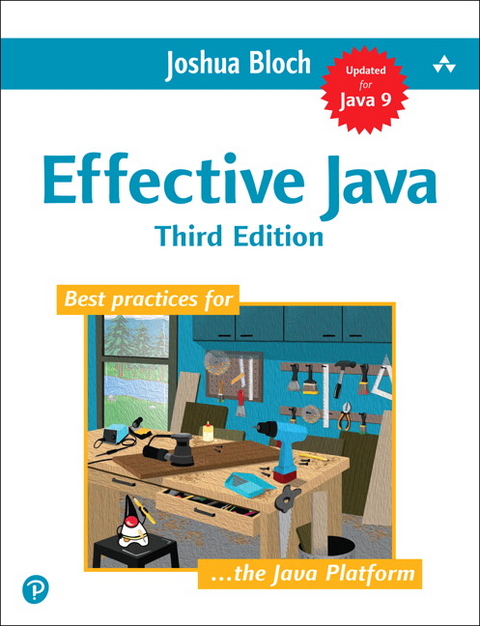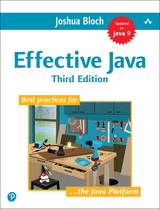Effective Java
Addison-Wesley (Verlag)
978-0-13-468599-1 (ISBN)
- Presents the most practical, authoritative guidelines available for writing efficient, well-designed programs for the Java platform
- Completely updated for Java releases since 2008
- Java programming paradigm has evolved significantly in last 5 years and new material covered in this edition is critical to modern Java programming
Since this Jolt-award winning classic was last updated in 2008 (shortly after Java 6 was released), Java has changed dramatically. In this new edition, Bloch updates the work to take advantage of Java's new language and library features, and provides specific best practices for their use.
Since this Jolt-award winning classic was last updated in 2008 (shortly after Java 6 was released), Java has changed dramatically.
The principal enhancement in Java 8 was the addition of functional programming constructs to Java's object-oriented roots. Java 7, 8, and 9 also introduced language features, such as the try-with-resources statement, the diamond operator for generic types, default and static methods in interfaces, the @SafeVarargs annotation, and modules.
New library features include pervasive use of functional interfaces and streams, the java.time package for manipulating dates and times, and numerous minor enhancements such as convenience factory methods for collections.In this new edition of Effective Java, Bloch updates the work to take advantage of these new language and library features, and provides specific best practices for their use.
Java's increased support for multiple paradigms increases the need for best-practices advice, and this book delivers. As in previous editions, each chapter consists of several "items," each presented in the form of a short, standalone essay that provides specific advice, insight into Java platform subtleties, and updated code examples.
The comprehensive descriptions and explanations for each item illuminate what to do, what not to do, and why.
Coverage includes:
- Updated techniques and best practices on classic topics, including objects, classes, methods, libraries, and generics
- How to avoid the traps and pitfalls of commonly misunderstood subtleties of the platform
- Focus on the language and its most fundamental libraries, such as java.lang and java.util
Joshua Bloch is a professor at Carnegie Mellon University. He was formerly the chief Java architect at Google, a distinguished engineer at Sun Microsystems, and a senior systems designer at Transarc. He led the design and implementation of numerous Java platform features, including the JDK 5.0 language enhancements and the Java Collections Framework. He holds a Ph.D. in computer science from Carnegie Mellon University and a B.S. in computer science from Columbia University. Normal 0 false false false EN-US X-NONE X-NONE
Foreword xi
Preface xiii
Acknowledgments xvii
Chapter 1: Introduction 1
Chapter 2: Creating and Destroying Objects 5
Item 1: Consider static factory methods instead of constructors 5
Item 2: Consider a builder when faced with many constructor parameters 10
Item 3: Enforce the singleton property with a private constructor or an enum type 17
Item 4: Enforce noninstantiability with a private constructor 19
Item 5: Prefer dependency injection to hardwiring resources 20
Item 6: Avoid creating unnecessary objects 22
Item 7: Eliminate obsolete object references 26
Item 8: Avoid finalizers and cleaners 29
Item 9: Prefer try-with-resources to try-finally 34
Chapter 3: Methods Common to All Objects 37
Item 10: Obey the general contract when overriding equals 37
Item 11: Always override hashCode when you override equals 50
Item 12: Always override toString 55
Item 13: Override clone judiciously 58
Item 14: Consider implementing Comparable 66
Chapter 4: Classes and Interfaces 73
Item 15: Minimize the accessibility of classes and members 73
Item 16: In public classes, use accessor methods, not public fields 78
Item 17: Minimize mutability 80
Item 18: Favor composition over inheritance 87
Item 19: Design and document for inheritance or else prohibit it 93
Item 20: Prefer interfaces to abstract classes 99
Item 21: Design interfaces for posterity 104
Item 22: Use interfaces only to define types 107
Item 23: Prefer class hierarchies to tagged classes 109
Item 24: Favor static member classes over nonstatic 112
Item 25: Limit source files to a single top-level class 115
Chapter 5: Generics 117
Item 26: Don’t use raw types 117
Item 27: Eliminate unchecked warnings 123
Item 28: Prefer lists to arrays 126
Item 29: Favor generic types 130
Item 30: Favor generic methods 135
Item 31: Use bounded wildcards to increase API flexibility 139
Item 32: Combine generics and varargs judiciously 146
Item 33: Consider typesafe heterogeneous containers 151
Chapter 6: Enums and Annotations 157
Item 34: Use enums instead of int constants 157
Item 35: Use instance fields instead of ordinals 168
Item 36: Use EnumSet instead of bit fields 169
Item 37: Use EnumMap instead of ordinal indexing 171
Item 38: Emulate extensible enums with interfaces 176
Item 39: Prefer annotations to naming patterns 180
Item 40: Consistently use the Override annotation 188
Item 41: Use marker interfaces to define types 191
Chapter 7: Lambdas and Streams 193
Item 42: Prefer lambdas to anonymous classes 193
Item 43: Prefer method references to lambdas 197
Item 44: Favor the use of standard functional interfaces 199
Item 45: Use streams judiciously 203
Item 46: Prefer side-effect-free functions in streams 210
Item 47: Prefer Collection to Stream as a return type 216
Item 48: Use caution when making streams parallel 222
Chapter 8: Methods 227
Item 49: Check parameters for validity 227
Item 50: Make defensive copies when needed 231
Item 51: Design method signatures carefully 236
Item 52: Use overloading judiciously 238
Item 53: Use varargs judiciously 245
Item 54: Return empty collections or arrays, not nulls 247
Item 55: Return optionals judiciously 249
Item 56: Write doc comments for all exposed API elements 254
Chapter 9: General Programming 261
Item 57: Minimize the scope of local variables 261
Item 58: Prefer for-each loops to traditional for loops 264
Item 59: Know and use the libraries 267
Item 60: Avoid float and double if exact answers are required 270
Item 61: Prefer primitive types to boxed primitives 273
Item 62: Avoid strings where other types are more appropriate 276
Item 63: Beware the performance of string concatenation 279
Item 64: Refer to objects by their interfaces 280
Item 65: Prefer interfaces to reflection 282
Item 66: Use native methods judiciously 285
Item 67: Optimize judiciously 286
Item 68: Adhere to generally accepted naming conventions 289
Chapter 10: Exceptions 293
Item 69: Use exceptions only for exceptional conditions 293
Item 70: Use checked exceptions for recoverable conditions and runtime exceptions for programming errors 296
Item 71: Avoid unnecessary use of checked exceptions 298
Item 72: Favor the use of standard exceptions 300
Item 73: Throw exceptions appropriate to the abstraction 302
Item 74: Document all exceptions thrown by each method 304
Item 75: Include failure-capture information in detail messages 306
Item 76: Strive for failure atomicity 308
Item 77: Don’t ignore exceptions 310
Chapter 11: Concurrency 311
Item 78: Synchronize access to shared mutable data 311
Item 79: Avoid excessive synchronization 317
Item 80: Prefer executors, tasks, and streams to threads 323
Item 81: Prefer concurrency utilities to wait and notify 325
Item 82: Document thread safety 330
Item 83: Use lazy initialization judiciously 333
Item 84: Don’t depend on the thread scheduler 336
Chapter 12: Serialization 339
Item 85: Prefer alternatives to Java serialization 339
Item 86: Implement Serializable with great caution 343
Item 87: Consider using a custom serialized form 346
Item 88: Write readObject methods defensively 353
Item 89: For instance control, prefer enum types to readResolve 359
Item 90: Consider serialization proxies instead of serialized instances 363
Items Corresponding to Second Edition 367
References 371
Index 377
| Erscheinungsdatum | 15.02.2018 |
|---|---|
| Verlagsort | New Jersey |
| Sprache | englisch |
| Maße | 189 x 231 mm |
| Gewicht | 684 g |
| Einbandart | kartoniert |
| Themenwelt | Informatik ► Programmiersprachen / -werkzeuge ► Java |
| Mathematik / Informatik ► Informatik ► Web / Internet | |
| Schlagworte | Java 9 (Programmiersprache); Handbuch/Lehrbuch • java programmieren |
| ISBN-10 | 0-13-468599-7 / 0134685997 |
| ISBN-13 | 978-0-13-468599-1 / 9780134685991 |
| Zustand | Neuware |
| Haben Sie eine Frage zum Produkt? |
aus dem Bereich




